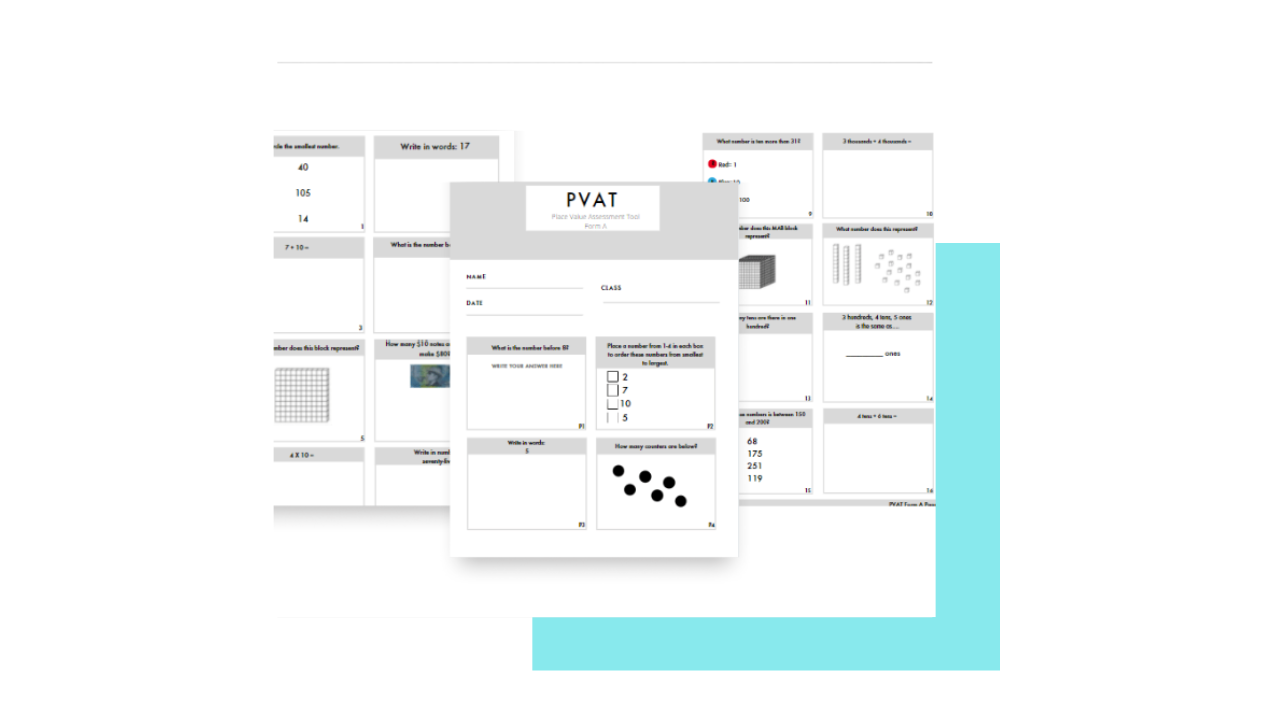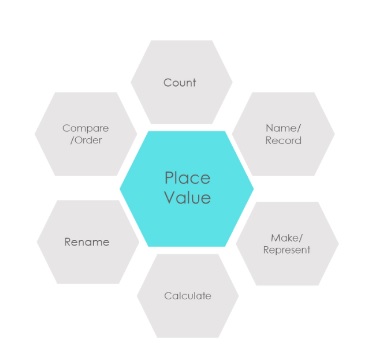Using the PVAT in your Class/School
Oct 20, 2022
In this blog I share a little more about the PVAT tool I developed in my four years of PhD research!
What is the PVAT?
The PVAT is a paper and pen assessment of Year 3-6 student’s whole number place value knowledge. The assessment was trailed with over 900 students through my PhD research, and using Rasch analysis it was shown to provide valid and reliable data across Year 3-6. The PVAT has two parallel versions, Form A and Form B, which can be used as a pre and post assessments. Form A and Form B are considered ‘parallel’, thus they are equivalent in difficulty. Having parallel test forms, allows us to measure the Effect Size of improvements students make as a result of our place value teaching.
What does the PVAT assess?
The PVAT is designed around the six aspects of place value. It focuses only on whole numbers. There are multiple questions that address name/record, count, make/represent, calculate, compare/order and rename.

Figure One: The Six Aspects of Place Value (Rogers, 2014)
In the PVAT there are some ‘easy’ questions in each of the six aspects, some ‘mid range’ and ‘difficult’ items (remember the PVAT covers Years 3-6). The difficulty of each item was calculated through trial phases in multiple schools and involved Rasch analysis. The PVAT is ordered from the least difficult item, through to the most difficult item. Students are encouraged to attempt as many questions as they can, but keep in mind they do become progressively more challenging. Students are given 60 minutes to complete the assessment.
Why the PVAT?
Before we teach place value, one of the six big ideas in Number (Siemon et al, 2012), it is important we gather data on our students’ current level of understanding. We must then use the data to inform our teaching and importantly target student needs (Siemon, 2017). To ensure the accuracy of the data we collect we need to use a comprehensive, high-quality assessment such as the PVAT. After all, any data we collect is only as good as the assessment we use. Many place value assessments do not address the six aspects of place value (trust me, I have checked!), and as such, do not provide teachers with a ‘full picture’ of student understanding. This then leads to gaps in our place value teaching, which denies students the opportunity to fully explore place value.
When should we use the PVAT?
Most schools start the school year teaching place value- particularly in Years 2-6. At the beginning of a school year there is often a flurry of assessments. For teachers it can be difficult to find a balance between gathering data and working on positive mindset messages. In order to address this, I have worked with several schools who collect the PVAT data at the conclusion of the previous school year. While there may be a little ‘learning loss’ over the Christmas break, generally the results hold true, and give an accurate indication of where the next teacher can begin instruction. In these schools, the current teacher administers the PVAT, but it is marked by the future teacher (as this is who will be teaching the content the following year). This gives the future teacher as good indication of the place value abilities within their class, even before they begin teaching.
In Term One, I advise using a six week block, each week focusing on a different place value aspect (you can read more about this in Rogers, 2017). Regular mini-assessments should take place within the six week block, to check if the targeted instruction within each aspect is working. After the six weeks, the PVAT Form B can be administered to measure the improvement of individual students, classes and year levels. Some schools decide to delay the Form B administration until June, this also provides timely data for report writing.
What data will the PVAT provide?
The PVAT provides data on your students understanding of place value, but it also allows you to evaluate your teaching. One of the most important questions for schools to consider around instruction is: Do we have evidence that what we are teaching is working? That is, are our students ‘catching what we are throwing?’. Once Form A and Form B data is gathered, effect sizes can be calculated (for year level cohorts). This provides quantitative evidence about the improvement the students have made over the teaching period.
The PVAT data can also be broken down to explore student cohort strengths and weaknesses in each of the six aspects of place value. I work with schools to create Guttman charts of their PVAT data and this provides some amazing insights for teachers. The Guttman allows you to see if your students are finding certain aspects more difficult than they should. For example, the data may show your Year 3 students are struggling with renaming. This leads to discussions around how you can change your teaching to have a stronger focus on this content. These data driven discussions are priceless.
For example, through analysing this Guttman Chart data in Figure Two, we noted that School A’s Year 3s needed to work on including non-canonical representations of numbers in the make/represent aspect of place value. This then became an important teaching focus for the Year 3 teachers.

Figure Two: School A’s Year 3 PVAT Guttman Chart Data
The PVAT also provides useful data related to where individual students ‘sit’ in place value across Years 3-6. There are very few assessments that allow this cross-year level comparison to be made. This provides amazing moderation opportunities and leads to critical discussions about developmentally appropriate teaching and learning. That is, if our data shows a large group of our Year 4’s are finding whole number place value difficult, do we just ‘plough on’ and introduce decimal place value, as suggested by the curriculum? These discussions support teachers to see that an alternative approach, where mastery, rather than time, is seen as the basis of curriculum advancement, (Masters, 2020), is not only workable, but necessary.
In order to gather an overall picture of student knowledge, PVAT raw scores can be easily translated into Place Value Stages of development. My research showed that student knowledge can be described in terms of four stages of place value development (Rogers, 2014). By looking at each student’s PVAT Stage and comparing these to my recommended Stages in each year level, teachers can gain an immediate understanding of who is ‘at risk’, at the ‘expected’ level and requires enrichment in place value. For example, Figure Three shows you the breakdown of School A’s PVAT Stage data across Years 3-6. If we look at Year 5, from my analysis of many school’s data, I consider any Year 5 students still in Stage 1 or 2 at risk in place value. If we look at Year 3, I would suggest students in Stage 3 and 4 require enrichment in place value. This information is useful for teachers to consider when reporting to parents.

Figure Three: School A PVAT data.
What do we do after the PVAT?
A good assessment program involves analysing assessment data with the aim to improve our teaching. So, my advice is to always learn from your PVAT data. If your students struggled with writing large numbers from Year 4, include this as a focus for the rest of the year. If they did really well in counting, pat yourselves on the back and consider how you could leverage this to further develop their renaming skills.
The schools who have improved student PVAT results each year, have used the six aspects to develop a whole school approach to their teaching of place value. Using the structure of the aspects combined with the PVAT data, has helped to develop the knowledge and confidence in teachers from Years 1 to 6. One school reported, that three years down the track, their Year 3s are coming in with greater place value knowledge when they first take the PVAT, and the development in their Year 6 student’s knowledge in whole numbers has helped them in decimal place value. This means quality teaching of place value is permeating through the whole school. I believe our overall aim in schools should be for the majority of our Year 5s to enter Year 6 as PVAT Stage Four ‘experts’ in whole number place value. Whilst this may seem like a lofty goal, I believe this is achievable when we use the PVAT data to guide our teaching.
Want to use the PVAT?
You can access Form A of the PVAT free on my website: https://www.numeracyteachersacademy.com/DrAnges-FREE-Resources
References
Masters, G. (2020). Time for a paradigm shift in school education? Australian Council for Educational Research. https://doi.org/10.37517/91645.2020.1
Rogers, A. (2014). Investigating whole number place value assessment in Years 3-6: Creating an evidence-based Developmental Progression (Unpublished Doctoral Dissertation). RMIT University, Melbourne, Australia.
Rogers, A (2017). Teaching Place Value: A Framework. Prime Number, 32(1), 19-21.
Siemon, D., Bleckly, J., and Neal, D. (2012). Working with the Big Ideas in Number and the Australian Curriculum: Mathematics. In B. Atweh, M. Goos, R. Jorgensen & D. Siemon, (Eds.). (2012). Engaging the Australian National Curriculum: Mathematics– Perspectives from the Field. Online Publication: Mathematics Education Research Group of Australasia pp. 19‐45.
Siemon, D. (2017, February 23). Targeting ‘big ideas' in mathematics. Teacher Magazine. https://www.teachermagazine.com/au_en/articles/targeting-big-ideas-in-mathematics
One more thing...
On Monday the 24th of October, I will be opening 40 new places my Numeracy Teachers Academy. If you are interested in joining the waitlist and being the first to know when I open the doors to teachers, leaders and schools click here.

